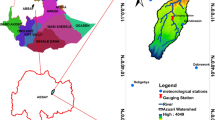Abstract
The planning of conservation measures to conserve water and soil resources taking hydrological planning unit as micro-watershed is considered to be effective. The automated watershed delineation technique using the spline interpolated filled digital elevation model (DEM) is effective in converging slopes of the area in which the stream patterns match with the manually digitized stream patterns of the topographical map. The various vector spatial layers like the slope/aspect, land-use/land-cover, runoff potential, soil erosion potential and the associated attribute information governing the criteria for different conservation structures can act as input layers in integrated spatial analysis module in GIS environment to evolve derived layers indicating the locations of conservation sites meeting the requisite criteria. The reliability of suitable conservation sites suggested out of integrated spatial GIS analysis could be ascertained using the multi criteria analysis incorporating the various factors controlling soil erosion process in the micro-watershed groups. The details of the above work are discussed in the paper.
Similar content being viewed by others
References
Band LE (1986) Topographic partition of watershed with digital elevation models. Water Resources Research 22(1): 15–24
Behera G and Mohapatra SS (1996) Integrated mission for sustainable development-A case study of Jamuna sagar watershed in Kalahandi district, Orissa. Proceeding of National work shop on application of Remote sensing and GIS techniques to integrated rural development, held at Hyderabad from June 14–15
Chagarlamudi P and Plunkett GW (1993) Mapping applications for low cost remote sensing and geographic information system. Int. Jour. Remote Sensing 14(17): 3181–3190
Chandrashekar G and Rao KHVD (1999) A case study on an integrated remote sensing and GIS approach in selecting suitable sites for water harvesting structures in the sub-watershed of Song river, Dehradun. Report of Indian Institute of Remote Sensing, Dehradun
Durbude DG and Venkatesh B (2004) Site Suitability Analysis for Soil and Water Conservation Structures. Indian Soc Remote Sens 32(4): 399–405
Freeman TG (1991) Calculating Catchment Area with divergent Flow Based on Regular Grid. Computer and Geosciences 17: 413–22
Jenson SK and Domingue JO (1988) Extracting topographic structure from digital elevation data for geographic information system analysis. Photogrammetric. Engg. and Remote Sensing 54(11): 1593–1600
Kumar P, Kumar S and Manchanda ML (2004) Satellite stereo data for DEM surfaces and derivatives. J. Indian Soc Remote Sens 32(1): 81–90
Liang C and Mackay DS (2000) A General Model of watershed Extraction and representation Using Globally Optimal Flow Paths and Upslope Contributing Areas. International Journal of Geographical Information Science 14: 337–58
Martz LW and Garbrecht J (1992) Numerical definition of drainage network and the sub-catchment areas from digital elevation models. Computer and Geosciences 18(6): 747–761
Moore ID (2000) Hydrological Modeling and GIS; GIS and Environmental Modeling: Progress and research issues, pp 143–48. Fort Colin, CO: GIS World Books
Ravindran KR, Promod Kumar, Tiwari AK Kudrat, Ravishankar M and Bhave SK (1992) Integrated approach for resources planning using remote sensing and GIS. A case study of Song watershed, Proceedings of National Symposium on Remote sensing for sustainable development, pp 11–15
Saaty TL (1977) A Scaling method for priorities in Hierarchical structures. Journal of Mathematical Pschology 15: 234–281
Saxena RK, Verma KS, Chary GR, Shristava R and Barthwal AK (2000) IRS-1C data application in watershed characterization and management. Int Journ Remote Sensing 21(17): 3197–3208
Singh G, Venkataramanan C, Sastry G and Joshi BP (1990) Textbook on manual of soil and water conservation practices, Oxford and IBH publishing Co. Pvt. Ltd., New Delhi
Srivastava VK and Mitra D (1995) Study of drainage pattern of Raniganj coalfield (Burdwan dist) as observed on Landsat TM/IRS LISS-III Imagery. J. Indian Soc Remote Sens 23(4): 225–235
USDA Soil Conservation Service Section 4: Hydrology (1972) National Engineering Handbook, DC, US Department of Agriculture
Vogt JV, Colombo R and Bertolo F (2003) Deriving drainage networks and catchment boundaries: A new methodology combining digital elevation data and environmental characteristics. Geomorphology, 53(3–4): 281–298
Author information
Authors and Affiliations
Corresponding author
About this article
Cite this article
Saptarshi, P.G., Raghavendra, R.K. GIS-based evaluation of micro-watersheds to ascertain site suitability for water conservation structures. J Indian Soc Remote Sens 37, 693–704 (2009). https://doi.org/10.1007/s12524-009-0057-z
Received:
Accepted:
Published:
Issue Date:
DOI: https://doi.org/10.1007/s12524-009-0057-z




